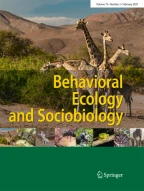Summary
-
1.
Electric organ discharge (EOD) volleys emitted by the electric catfish, Malapterurus electricus, were recorded and sampled for 108 consecutive hours from the fish's natural habitat, a selected study area in the Swashi River, a tributary of the man-made Lake Kainji in Nigeria.
-
2.
M. electricus intermittently generates different types of EOD volleys that start with a high-frequency phase, and range in duration from 2 ms to over 8 s with from 2 to over 600 pulses (EODs).
-
3.
The catfish's EOD activity exhibited a daily activity rhythm which was correlated with local changes in light intensity. The EOD activity remained at a constant level throughout the day from 0700 h to 1800 h. Shortly after sunset, between 1800 h and 1900 h, it increased fivefold to its peak value at 1900 h. The occurrence of EOD volleys declined throughout the night with a noticeable drop to the daytime low after sunrise between 0600 h and 0700 h. During the first 6 h following sunset, the volleys were significantly longer and consisted of more EODs than the daytime volleys. It is inferred that M. electricus feeds most successfully during the early hours of the night.
-
4.
A hitherto unknown type of Malapterurus EOD activity was discovered: during night-time, volleys consisting of more than 16 EODs were occasionally preceded by a low-frequency train of from 1 to 11 EODs. The occurrence rate of these pre-volley EODs was positively correlated with the duration of the ensuing volley (and its number of EODs). The peak pre-volley activity occurred during the first 4 h after sunset, with an average of 38% of all volleys preceded by this type of activity. The adaptive significance of the nocturnal pre-volley EODs as prey detection mechanism is discussed.
Similar content being viewed by others
References
Bauer, R.: Untersuchungen zur Entladungstätigkeit und zum Beutefangverhalten des Zitterwelses Malapterurus electricus Gmelin 1789 (Siluroidea, Malapteruridae, Lacep. 1803). Z. vergl. Physiol. 59, 371–402 (1968)
Bauer, R.: La décharge électrique pendant le comportement alimentaire de Electrophorus electricus. J. Physiol. (Paris) 62, 341–342 (1970)
Bauer, R.: Electric organ discharge (EOD) and prey capture behaviour in the electric eel, Electrophorus electricus. Behav. Ecol. Sociobiol. 4, 311–319 (1979)
Belbenoit, P.: Comportement alimentaire et décharge électrique associée chez Torpedo marmorata (Selachii, Pisces). Z. vergl. Physiol. 67, 205–216 (1970)
Belbenoit, P., Bauer, R.: Video recordings of prey capture behavior and associated electric organ discharge of Torpedo marmorata (Chondrichthyes). Mar. Biol. 17, 93–99 (1972)
Kalmijn, A.: The detection of electric fields from inanimate and animate sources other than electric organs. In: Handbook of sensory physiology, Vol. III/3. Fessard, A.E. (ed.), pp. 147–200. Berlin, Heidelberg, New York: Springer 1974
Moller, P., Serrier, J., Belbenoit, P., Push, S.: Notes on ethology and ecology of the Swashi River mormyrids (Lake Kainji, Nigeria). Behav. Ecol. Sociobiol. 4, 357–368 (1979)
Pfeiffer, W.: Zur Biologie des Zitterrochens (Torpedo marmorata). Pubbl. Stn. Zool. Napoli 32 167–171 (1961)
Pickens, P.E., McFarland, W.N.: Electric discharge and associated behaviour in the stargezer. Anim. Behav. 12, 362–367 (1964)
Scheich, H., Bullock, T.H.: The detection of electric fields from electric organs. In: Handbook of sensory physiology, Vol. III/3. Fessard, A.E. (ed.), pp. 201–256. Berlin, Heidelberg, New York: Springer 1974
Siegel, S.: Nonparametric statistics. New York, Toronto, London: McGraw-Hill 1956
Szabo, T.: Anatomo-physiologie des centres nerveux spécifiques de quelques organes électriques. In: Bioelectrogenesis, Chagas, C., Paes de Carvalho, A. (eds.), pp. 185–201, Amsterdam, Elsevier 1961
Wilson, D.: Notes from the Plymouth aquarium II. J. Mar. Biol. Assoc. 32, 199–208 (1953)
Author information
Authors and Affiliations
Additional information
Supported by grants from the National Geographic Society, the City University of New York (PSC-BHE 11478E), and the Explorers Club to P.M.; the C.N.R.S. Recherche Coopérative sur Programme No. 350 to P.B. and J.S. Facilities and assistance were provided by the Kainji Lake Research Institute, New Bussa, Nigeria
Rights and permissions
About this article
Cite this article
Belbenoit, P., Moller, P., Serrier, J. et al. Ethological observations on the electric organ discharge behaviour of the electric catfish, Malapterurus electricus (Pisces). Behav Ecol Sociobiol 4, 321–330 (1979). https://doi.org/10.1007/BF00303240
Received:
Issue Date:
DOI: https://doi.org/10.1007/BF00303240




